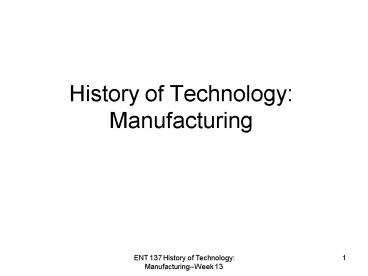History of Technology: Manufacturing - PowerPoint PPT Presentation
1 / 12
Title:
History of Technology: Manufacturing
Description:
Some of the simple machines-- wheel, lever, incline plane, ... manufacturers (e.g., GE, Omark, Kawasaki) were successful implementing some of these methods. ... – PowerPoint PPT presentation
Number of Views:362
Avg rating:3.0/5.0
Title: History of Technology: Manufacturing
1
History of Technology Manufacturing
2
Brief History of Manufacturing
- Some of the simple machines-- wheel, lever,
incline plane, pulley and screw-- were used as
early as 3000 BC. - During the Medieval times gears, were used to
transmit power, and cams and rods were used to
convert circular motion to reciprocal motion. - However, mechanization, combining simple machines
to make compound machines, did not become a
common part of manufacturing until the late
1700's. Boring mill, screw cutting lath, planing
machine, drill press, milling machine, and gear
cutting machine were some of the machines
developed during the Industrial Revolution. These
new machines made part production quicker and
more accuracy.
3
(No Transcript)
4
Brief History of Manufacturing
1712--Thomas Newcome captured the energy of heat
with the steam engine. By 1758, there were more
than 100 engines built primarily for use in mines
to pump water. Although, the Newcome steam
engine was too large and costly for widespread
application, it did show that piston engines
could convert heat energy to mechanic energy.
James Watt improved the steam engine by adding a
separate condenser to convert the steam back into
water. The result was a smaller, more powerful
and less expensive engine. The Watt's steam
engine was more practical for industrial
application.
5
Brief History of Manufacturing
- 1793Eli Whitney invents cotton gin. In 1798
Whitney receives government contract to mass
produce army muskets. By 1799 he perfects concept
of interchangeable parts. - 1818Whitney develops milling machine and Thomas
Blanhard develops machine to copy rifle stocks. - 1799-1899developments focused on individual
technologies (engineering drawing system, machine
tools, steel manufacturing-Bessemer) - Americans Elias Howe, Isaac Singer (sewing
machines) and Cyrus McCormack (harvesters) and
Henry Ford (automobiles) followed with inventions
and innovations that used Whitney's examples of
mass production and interchangeable parts.
6
Brief History of Manufacturing
- The principle of the piston engine (developed by
Newcome in 1712) led to the development of
Nikolaus Otto's internal combustion engine in
1859 and the diesel engine invented by Rudolf
Diesel in 1898. - Electric motors were also invented during this
time period. In 1831, showed that a wire
carrying an electric current would move if placed
in a magnetic field. Thus electricity could be
converted to motion. It was this discovery that
led to the development of the first electric
motor constructed by Joseph Henry in 1831. - These new sources of power, which converted heat
or electrical energy to mechanical energy,
changed manufacturing industries. The
mechanization of production could now be done on
a large scale. Mechanization increased the
quantity of manufactured goods while decreasing
the cost of production.
7
Brief History of Manufacturing
- 1890sFocus moved toward examining work methods,
worker managements, standardized work methods,
time and motion, worker motivation, etc. Key
players Frederick Taylor and Frank and Lillian
Gilbreth. - 1910The Ford System was beginning to take shape
(Henry Ford and Charles Sorenson). They took all
the elements of a manufacturing system-- people,
machines, tooling, and products-- and arranged
them in a continuous system for manufacturing the
Model T automobile.
8
Brief History of Manufacturing
9
Brief History of Manufacturing
10
Brief History of Manufacturing
- 1920sWas period of prosperity until the 1929
stock market crash and The Great Depression.
During the 1920s labor unions began to form
which resulted in conflict with the Ford system. - Product proliferation also put strains on the
Ford system. Annual model changes, multiple
colors, and options did not fit well in Ford
factories. - Alfred Sloan (General Motors) did respond to
these changes and by 1930s GM had surpassed Ford
in automobile production.
11
Brief History of Manufacturing
- 1949-1975A great deal of work was done on
quality systems, reducing setup and changeover
problems, worker involvement and morale, improved
product variety, reducing batch sizes, and
approaching a just-in-time inventory process.
Much of this was being led by Japan and more
specifically Toyota. This was the beginning of
what was to be the Toyota Production System or
Lean Manufacturing. - 1980s-some US manufacturers (e.g., GE, Omark,
Kawasaki) were successful implementing some of
these methods.
12
Brief History of Manufacturing
- 1980sThe term World Class Manufacturing was
coined and began to catch more wide-spread
attention. - 1990sJames Womak writes The Machine that
Changed the World. This was a straightforward
account of the history of automobile
manufacturing combined with a study of Japanese,
American, and European automotive assembly
plants. What was new was a phrase-- "Lean
Manufacturing - Todaythe term Lean Manufacturing is synonymous
with the Toyota Production System.































